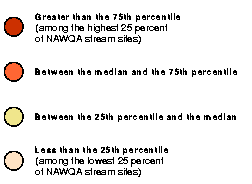|
Seven major water-quality characteristics were evaluated for stream sites in each NAWQA Study Unit. Summary scores for each characteristic were computed for all sites that had adequate data. Scores for each site in the San Joaquin-Tulare Basins Study Unit were compared with scores for all sites sampled in the 20 NAWQA Study Units during 1992-95. Results are summarized by percentiles; higher percentile values generally indicate poorer quality compared with other NAWQA sites. Water-quality conditions at each site also are compared to established criteria for protection of aquatic life. Applicable criteria are limited to nutrients and pesticides in water and semivolatile organic compounds (SVOC), organochlorine pesticides, and PCBs in sediment. (Methods used to compute rankings and evaluate aquatic-life criteria are described by Gilliom and others, in press.) |
|
STUDY AREA showing inset
|
EXPLANATION

|
 |
FISH COMMUNITY DEGRADATIONHigh percentages of fish at sites in the fixed-site network were nonnative, omnivores, diseased or deformed, or tolerant of human-caused stream degradation. Disease or deformity includes external parasites, tumors, and skeletal deformities. All sites received the poorest score for percentage of non-native species and percentage of fish with external anomalies. Fish communities at all sites were scored as highly degraded when compared with fish communities at other sites across the Nation. |
 |
STREAM HABITAT DEGRADATIONPhysical characteristics of streams can have substantial effects on water chemistry and aquatic life. On the basis of stream modification, bank erosion, bank stability, and riparian vegetation density, sites in the Study Unit were moderately to highly degraded when compared with other sites in the Nation. There are no standards or guidelines that apply to stream habitat. |
 |
ORGANOCHLORINE PESTICIDES and PCBs in bed sediment and biological tissueConcentrations of organochlorine chemicals in the Study Unit, particularly DDT com-pounds and toxaphene, were high in bed sediment and tissues of fish or clams. Levels at some sites were among the highest in the Nation. |
 |
PESTICIDES in waterConcentrations of dissolved pesticides in the Study Unit were among the highest of all NAWQA sites nationwide. For many pesticides, this Study Unit had the max-imum concentration of all 20 Study Units. All sites exceeded the aquatic-life criteria for at least one pesticide at least 17 percent of the time. However, drinking-water-quality standards were not exceeded. |
 |
TRACE ELEMENTS in bed sedimentConcentrations of trace elements in bed sediment generally were higher than concentrations found in other NAWQA Study Units. |
 |
NUTRIENTS in waterNutrient concentrations in the Study Unit ranged from very low to one of the highest in the Nation. The high concentrations occur at sites that are downstream from agricultural drainage or wastewater-treatment plant discharge. Ammonia concentrations exceeded guidelines for fish toxicity at three sites in the Study Unit. |
 |
SEMIVOLATILE ORGANIC COMPOUNDS in bed sedimentFew SVOCs were detected in the Study Unit. Those detected were usually found at low concentra-tions, and values were low compared with other sites in the Nation. Criteria for protection of aquatic life were not exceeded. |
CONCLUSIONSThe Study Unit is in poor condition compared with the other 19 Study Units in the categories of fish communities, PCBs, and organochlorines in streambed sediment and fish tissue, and pesticides in the water. Several sites exceeded guidelines and criteria, and the occurrence of nonnative fish species and fish with external anomalies were especially high in the Study Unit. Stream habitat and nutrient concentrations in water were close to the median for the 20 Study Units. Only the occurrence and concentrations of SVOCs in sediment were low relative to the other Study Units. |